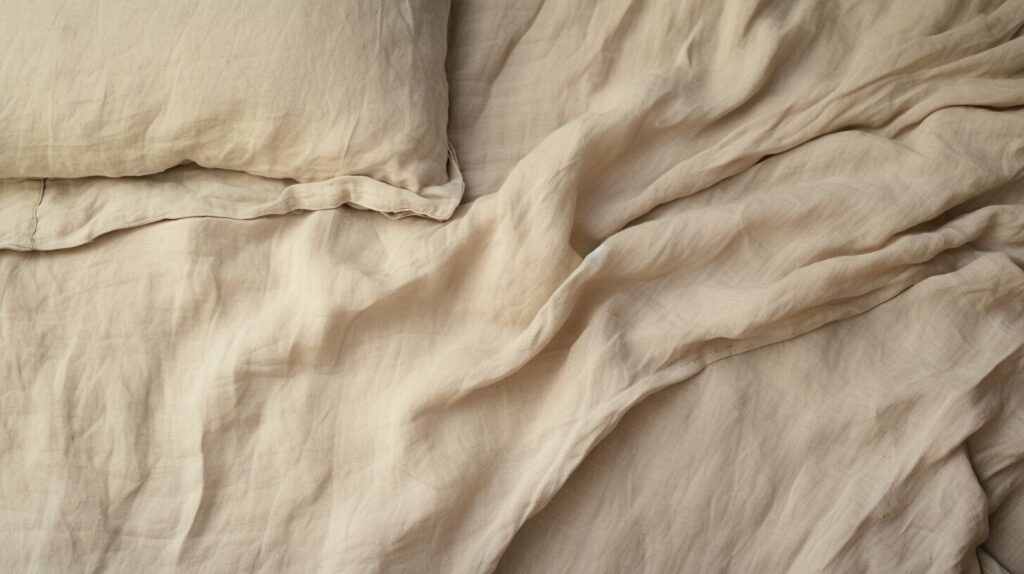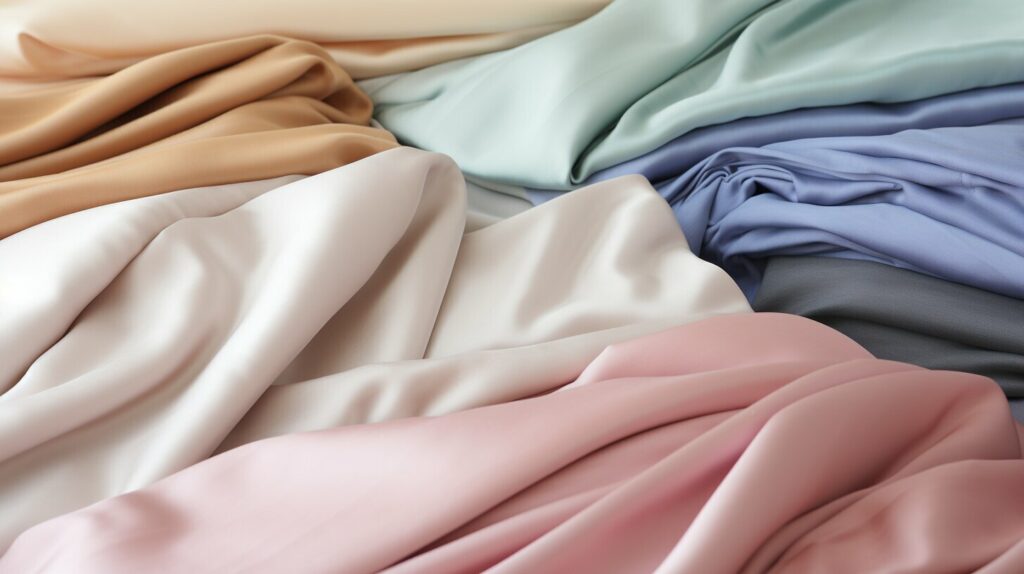Best Bedding Materials to Enhance Your Sleep
Are you looking for the best bedding materials to enhance your sleep? Look no further! In this detailed guide, we’ll explore a wide range of bedding material options to help you make an informed choice that matches your comfort, style, and wellness needs.
Picking the right fabric can make a world of difference—not just in how cozy your bed feels, but in how rested you wake up. From breathable cotton to silky indulgence, every material has its own story, and we’re here to help you figure out which one’s perfect for you.
Key Takeaways:
- Choosing the right bedding material is essential for a comfortable, restful sleep experience.
- Cotton is known for elegance, versatility, and breathability, while silk offers luxury, beauty, and wellness benefits.
- Different weaves like percale and sateen affect cotton’s texture and warmth levels.
- Silk is hypoallergenic, regulates temperature, and is gentle on hair and skin but needs delicate care.
- Other bedding materials like bamboo-derived rayon, linen, flannel, polyester, microfiber, and Tencel each offer unique perks depending on your preferences and lifestyle.
The Elegance and Breathability of Cotton
Cotton has long been a go-to for cozy, high-quality bedding. Its natural fibers provide a luxurious softness while being durable enough to withstand years of washing and wear. With cotton, you get the best of both worlds: comfort and practicality.
Whether you’re curling up under crisp percale sheets or sinking into the silky-smooth finish of sateen, cotton adapts beautifully to your sleep habits. Did you know cotton’s breathability also helps regulate your body temperature, keeping you cool in the summer and warm in the winter? No wonder it’s a favorite in households worldwide.
Remember, the quality of cotton matters too—look for long-staple varieties like Egyptian or Pima for extra softness and durability. Plus, cotton is easy to maintain and pairs beautifully with layered bedding like quilts, throws, and duvets.

For more on cotton’s benefits, check out our post on bedding materials and benefits.
The Luxurious Beauty of Silk
Silk has long been a symbol of indulgence and sophistication. But beyond its beauty, silk offers several sleep-enhancing benefits. Its smooth surface minimizes friction on hair and skin, reducing tangles, wrinkles, or irritation.
Silk naturally repels dust mites and allergens, making it a great choice for sensitive sleepers. Unlike synthetic fabrics, silk regulates temperature beautifully—it keeps you cool when it’s hot and warm when it’s cold.
To maintain silk bedding, gentle care is key: use mild detergent, wash on delicate or hand wash, and air dry whenever possible. Investing in silk might feel luxurious, but many say it’s worth it for the comfort and health perks. Curious how it compares to cotton? Read more at Mulberry Park Silks.

Eco-Friendly Bamboo-Derived Rayon
Bamboo-derived rayon is a favorite for eco-conscious shoppers. It starts with fast-growing bamboo, which needs no pesticides, making it sustainable. Once transformed into rayon, it becomes an ultra-soft, breathable fabric that feels cool to the touch.
Bamboo sheets are loved for moisture-wicking, keeping sweaty sleepers dry. They’re naturally antimicrobial, reducing odors and bacteria over time. If you care about the planet but want comfort, bamboo-derived rayon offers a perfect balance of sustainability and luxury.
Just follow care instructions to extend its lifespan. Whether paired with organic cotton or layered under a lightweight duvet, bamboo adds softness and peace of mind.

Rustic Charm with Linen
Linen bedding delivers rustic charm like no other. Woven from flax fibers, linen’s slightly textured feel softens dramatically over time. Its loose weave allows for incredible airflow, making it super breathable—perfect for warm sleepers or summer nights.
Though linen wrinkles easily, many embrace these soft crinkles as part of its cozy, lived-in look. Plus, it’s one of the most durable fabrics; with proper care, it can last decades.
Its hypoallergenic and moisture-wicking properties also make it smart for sensitive skin. Want to elevate your bedroom? Try mixing linen with cotton or layering linen throws for a textured, boutique look. Its earthy color palette can beautifully transform your space into a serene retreat.

Warm and Snug with Flannel
When chilly weather rolls in, flannel sheets are the ultimate cozy companion. Made from cotton or wool, flannel’s brushed finish traps air and retains body heat, providing a comforting cocoon on cold nights.
Flannel is especially popular in long-winter regions, but it’s great for anyone who loves that warm, fuzzy feel year-round. High-quality flannel resists pilling and stays soft after many washes.
When shopping, check the weight—heavier flannel equals more warmth. Look for plaid or solid patterns to add nostalgic, cabin-like charm. To keep flannel fresh, wash on gentle and avoid high heat. Pair flannel sheets with a down comforter for an irresistibly toasty bed.

Affordable Options: Polyester and Microfiber
Looking for comfort on a budget? Polyester and microfiber sheets deliver soft, easy-care bedding at wallet-friendly prices. Polyester resists shrinking, stretching, and wrinkles, making it perfect for busy homes or guest rooms.
Microfiber, made from ultra-fine polyester strands, offers a plush, suede-like feel and is often hypoallergenic. These synthetics dry quickly, need minimal ironing, and hold up after many washes.
While they may not breathe as well as natural fibers, they excel in durability and price. Plus, they come in endless colors and patterns, letting you refresh your bedroom affordably. They’re great for kids’ rooms, vacation homes, or anyone needing easy-maintenance bedding.

Sustainable Luxury with Tencel
Tencel, or lyocell, is a modern bedding material prized for silky softness and sustainability. Made from sustainably harvested wood pulp, Tencel production uses a closed-loop process that recycles water and solvents, minimizing environmental impact.
The result? A luxuriously smooth, breathable fabric that feels gentle on skin and regulates temperature beautifully. Tencel sheets are naturally hypoallergenic, making them great for sensitive sleepers. They resist wrinkles and shrinkage better than some natural fibers.
As Tencel gains popularity, it’s available in a variety of price points and styles, from minimalist solids to elegant patterns. For eco-minded shoppers wanting comfort and conscience, Tencel delivers. Pair it with organic cotton or bamboo for a fully sustainable sleep setup that’s kind to the planet and your skin.

FAQ
What is the most breathable bedding material?
Cotton and linen are among the most breathable fabrics, perfect for hot sleepers or warm climates. Their natural fibers let air circulate, preventing heat buildup for cooler, more comfortable sleep.
Are silk sheets worth the investment?
Absolutely! While silk sheets can be expensive, they offer a luxurious feel, reduce friction on hair and skin, and are naturally hypoallergenic. Many people find the long-term comfort and beauty well worth the cost.
What’s the best bedding material for allergies?
Silk, bamboo-derived rayon, and Tencel are excellent hypoallergenic choices that resist dust mites, mold, and mildew. They help create a cleaner sleep space for sensitive skin or allergy sufferers.
How do I care for delicate bedding like silk?
Delicate fabrics like silk require special care: use a gentle detergent, wash on delicate or by hand, and air dry. Always follow the care label to maintain the beauty and longevity of your silk bedding.
Which bedding material lasts the longest?
High-quality cotton (like Egyptian or Pima) and linen are renowned for durability when properly cared for. With regular maintenance, these natural fibers can last for years, offering both comfort and value.













